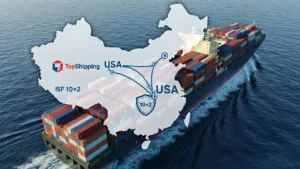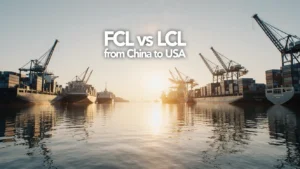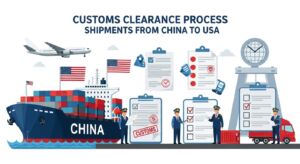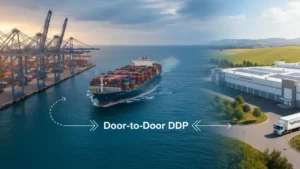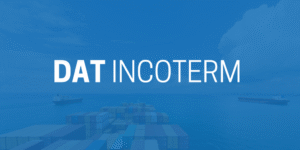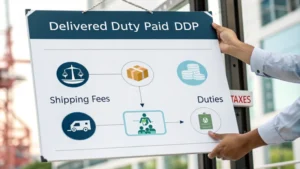The CPT Incoterms (Carriage Paid To) is one of the most widely used rules in international trade for multimodal transport – for example, when shipping from China to US – allowing the seller to pay for transport to a named destination while transferring risk to the buyer earlier in the shipment process. Defined by the International Chamber of Commerce (ICC) in its Incoterms 2020 publication, CPT outlines a specific set of obligations where the seller pays for transport to a named destination, but the risk of loss or damage transfers to the buyer much earlier in the shipment process.
For businesses engaged in cross-border trade, mastering the CPT meaning is crucial. It simplifies logistics by clearly defining two distinct points: the point of cost transfer (the destination) and the point of risk transfer (the place of delivery to the carrier). This dual structure requires both sellers and buyers to be diligent regarding insurance and contractual specifics.
What is CPT (Carriage Paid To)?
CPT is a multimodal Incoterm where the seller covers the freight costs to bring the goods to a specified destination agreed upon with the buyer. It belongs to the “C” group of Incoterms, characterized by the seller assuming carriage costs beyond the point of risk transfer.
The Two Critical Points in CPT
Unlike many other Incoterms, CPT establishes two separate critical points:
- Risk Transfer Point (Place of Delivery): The seller is deemed to have “delivered” the goods and risk passes to the buyer when the goods are handed over to the first carrier contracted by the seller. This typically occurs in the seller’s country.
- Cost Transfer Point (Named Place of Destination): The seller is responsible for paying the freight costs up to this named point, which is often a terminal, port, or warehouse in the buyer’s country.
This separation means the buyer assumes the risk during the main carriage, even though the seller paid for that transport.
Seller and Buyer Responsibilities Under CPT Incoterms 2020
Clarity on who handles specific tasks, costs, and risks is the primary function of the CPT Incoterm. The following table provides a clear breakdown of the core obligations:
CPT Obligations Summary Table
| Responsibility Area | Seller (A) | Buyer (B) |
| Delivery & Risk Transfer | Delivers to the first carrier. Bears risk until this point. | Bears risk from the moment the goods are handed to the first carrier. |
| Main Carriage Cost | Arranges and pays for transport (freight) to the named destination. | None. |
| Export Formalities | Must handle and pay for all export clearance, duties, and security. | None. |
| Import Formalities | None. | Must handle and pay for all import clearance, duties, taxes (VAT/GST). |
| Insurance | No obligation, but may purchase for their own risk coverage until delivery. | Strongly advised to purchase insurance covering the main carriage. |
| Final Delivery | None. | Arranges and pays for transport from the named destination to the final location. |
Practical Example of a CPT Shipment
Understanding how Carriage Paid To works in a real-world scenario highlights the split responsibility:
Imagine a U.S. electronics manufacturer (Seller) sells machinery to a distributor in the UAE (Buyer) under the term CPT, Jebel Ali Port, Dubai, UAE.
- Seller’s Actions: The U.S. seller packs the goods, completes U.S. export customs, and contracts a shipping line to move the container from their factory (e.g., in Ohio) to Jebel Ali Port, paying the full freight charge.
- Risk Transfer: The risk passes to the UAE buyer immediately when the goods are loaded onto the truck (the first carrier) at the Ohio factory, or at the freight forwarder’s warehouse.
- Transit: If the container is lost at sea, the buyer bears the loss and must file a claim with their insurance company (if purchased). The seller’s obligation to pay freight remains, but their risk is gone.
- Buyer’s Actions: Upon arrival at Jebel Ali Port, the buyer is responsible for:
- Unloading the goods (if not included in the freight).
- Handling all UAE import clearance and paying local duties/taxes.
- Arranging and paying for transportation from Jebel Ali Port to their final warehouse.
CPT Advantages and Disadvantages
Choosing the CPT Incoterm should be based on a clear analysis of how it aligns with your company’s logistics capabilities and risk tolerance.
Advantages of CPT
- For the Buyer: Convenience, as the seller organizes and pays for the complex international shipping leg.
- For the Seller: Clear transfer of risk early in the process (upon handover to the carrier), minimizing exposure to long-haul transit risks.
- Flexibility: CPT is suitable for all modes of transport, making it an excellent default choice for containerized and multimodal shipments.
Disadvantages of CPT
Risk Timing for Buyer: The biggest drawback. The buyer assumes the risk of loss or damage while the goods are physically far from them, and they have no control over the main carrier selection.
- Insurance Liability: Since the seller is not required to provide insurance, the burden falls on the buyer to ensure adequate coverage.
- Destination Costs: The buyer is fully responsible for unexpected terminal handling charges, import clearance delays, and fluctuating import duties.
CPT vs. CIP vs. DDP: Clarifying the Key Differences
Understanding the core distinction between CPT and related “C” and “D” group Incoterms is essential for proper contract drafting.
CPT vs. CIP (Carriage and Insurance Paid To)
The primary difference lies in insurance.
- CPT: The seller pays for carriage, but is not obligated to provide insurance. The buyer must arrange insurance to cover their risk.
- CIP(Carriage and Insurance Paid): The seller pays for carriage AND is mandatorily required to purchase cargo insurance. Under Incoterms 2020, this insurance must provide the highest level of coverage (Institute Cargo Clauses (A) or equivalent), covering at least 110% of the contract value.
CPT vs. DDP (Delivered Duty Paid)
These terms represent opposite ends of the seller’s responsibility spectrum.
- CPT: The seller pays for carriage only. The buyer handles all import clearance and duties.
- DDP(Delivered Duty Paid): The seller takes on the maximum obligation, handling carriage, all export/import clearance, and paying all duties and taxes to deliver the goods ready for unloading at the final specified place.
Calculating the CPT Cost (Total Landed Cost)
For a buyer, the true cost under CPT is the total landed cost. When calculating this, businesses must look beyond the freight charge the seller pays.
Total CPT Cost = (Goods Price) + (Seller’s Paid Freight Cost) + (Buyer’s Local Costs)
The buyer’s local costs include:
- Insurance Premium (Highly Recommended).
- Import Duties, Tariffs, and VAT/GST.
- Destination Terminal Handling Charges (THC), if not included in the seller’s freight contract.
- Customs Broker Fees and Documentation Fees.
- Local Transport from the named destination to the buyer’s facility.
Conclusion and Strategic Partnership
The CPT Incoterm offers a balanced approach for global trade, especially for multi-mode shipments, by ensuring the seller manages the main logistics while placing the responsibility for destination clearance and risk mitigation firmly with the buyer. This division requires precise planning and execution from both parties.
For exporters utilizing CPT, professional logistics management is paramount to ensure timely delivery and proper documentation that satisfies the buyer.
Ready to streamline your CPT shipments and guarantee compliance under Incoterms 2020?
Partner with Topshipping. We specialize in managing the seller’s obligations in the CPT rule, ensuring seamless export clearance and contracting reliable global carriers to the named destination. Contact us today for an accurate freight quote and expert consultation on your next international shipment.
FAQ : (CPT) Incoterms
What is the difference between CPT and FOB?
CPT (Carriage Paid To) applies to all transport modes, while FOB (Free On Board) is only for sea and inland waterway transport.
Under CPT, the seller pays for the main transport to the destination but risk transfers to the buyer once the goods are handed to the first carrier.
Under FOB, the seller’s responsibility ends only when the goods are loaded onto the ship at the port of shipment.
Who pays for CPT Incoterms?
In CPT terms, the seller pays for the main carriage (freight) to the agreed destination and handles export customs clearance.
The buyer pays for insurance (if desired), import duties, taxes, unloading, and any further transport after arrival.
What is the difference between CPT and CPI (CIP)?
CPT (Carriage Paid To) and CIP (Carriage and Insurance Paid To) are very similar. The difference is that in CPT, the seller is not required to insure the goods, while in CIP, the seller must obtain insurance coverage for the buyer’s benefit until the goods reach the named destination.
When should CPT Incoterms be used?
CPT is best used when the seller can efficiently arrange and pay for transportation, but the buyer is willing to take the risk once goods are handed to the first carrier. It’s ideal for multimodal shipments (air freight, road, or combined transport) where the buyer wants predictable freight costs but can handle insurance or risks independently.
Can CPT be used for sea freight?
Yes. CPT can be used for sea freight, but it is not limited to it. It’s suitable for any mode of transport, including air, road, or rail. However, for traditional sea shipments, terms like CFR or CIF are more common.
Is CPT the same as DAP?
No, CPT and DAP are not the same. In CPT, the seller pays for transportation to the destination but the risk transfers to the buyer once the goods are handed to the first carrier.
In DAP (Delivered at Place), the seller bears both cost and risk until the goods arrive at the agreed destination, ready for unloading.
What is the difference between CPT and DDP?
Under CPT, the seller pays for the transport but the risk transfers early at delivery to the first carrier — and the buyer handles import duties, taxes, and unloading.
Under DDP (Delivered Duty Paid), the seller takes full responsibility for transportation, risk, import customs, and delivery to the buyer’s location.
In short: CPT splits responsibility; DDP puts almost everything on the seller.
What is the difference between CPT and CIF?
CPT and CIF differ mainly in transport mode, insurance, and risk point.
CPT can be used for any transport mode and doesn’t require seller-provided insurance.
CIF (Cost, Insurance, and Freight) applies only to sea transport, and the seller must pay for minimum insurance.
In CPT, risk passes when goods are given to the first carrier; in CIF, it passes when goods are loaded on the ship.
What is the main difference between CPT and CIP?
Both involve the seller arranging and paying for transportation to a named destination.
The only main difference is insurance — under CIP, the seller must provide insurance coverage for the buyer; under CPT, the seller has no such obligation.
What is CFR vs CPT vs CIF?
- CFR (Cost and Freight): Seller pays for sea freight to the destination port; risk passes once goods are loaded on the ship.
- CIF (Cost, Insurance, and Freight): Same as CFR, but seller must also provide insurance.
- CPT (Carriage Paid To): Similar concept but valid for all transport modes; seller pays freight to the destination, risk passes earlier when goods are handed to the first carrier.
What is CPT in Amazon Warehouse?
In Amazon’s logistics or FBA context, CPT (Carriage Paid To) means the seller arranges and pays for transport to the Amazon fulfillment center, but the risk transfers to Amazon (as buyer or receiver) when the goods are handed to the first carrier. It’s often used when third-party logistics companies (3PLs) handle shipments from the seller to Amazon warehouses.








